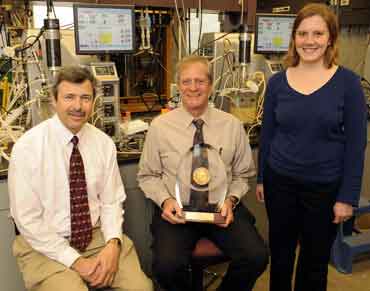Growing a fungus in some of the leftovers from ethanol production can clean up and improve the dry-grind ethanol production process, according to a team of researchers from Iowa State University and the University of Hawaii.
'The process could change ethanol production in dry-grind plants so much that energy costs can be reduced by as much as one-third,' said Hans van Leeuwen, an Iowa State professor of civil, construction and environmental engineering.
Van Leeuwen and the other researchers developing the technology recently won the 2008 Grand Prize for University Research from the American Academy of Environmental Engineers for the project.
The dry-grind ethanol production process itself grinds corn kernels and adds water and enzymes. The enzymes break the starches into sugars. The sugars are fermented with yeasts to produce ethanol.
The fuel is recovered by distillation, but there are about six gallons of leftovers for every gallon of fuel that's produced. Those leftovers, known as stillage, contain solids and other organic material. Most of the solids are removed by centrifugation and dried into distillers dried grains that are sold as livestock feed, primarily for cattle.
The remaining liquid, known as thin stillage, still contains some solids, a variety of organic compounds from corn and fermentation as well as enzymes. Because the compounds and solids can interfere with ethanol production, only about 50 per cent of thin stillage can be recycled back into ethanol production. The rest is evaporated and blended with distillers dried grains to produce distillers dried grains with solubles.
The researchers added a fungus, Rhizopus microsporus, to the thin stillage and found it would feed and grow. The fungus removes about 80 per cent of the organic material and all of the solids in the thin stillage, allowing the water and enzymes in the thin stillage to be recycled back into production.
The fungus can also be harvested. It is s a food-grade organism that's rich in protein, certain essential amino acids and other nutrients. It can be dried and sold as a livestock feed supplement. Or it can be blended with distillers dried grains to boost its value as a livestock feed and make it more suitable for feeding pigs and chickens.
Van Leeuwen estimated it would cost $11m to start using the process in an ethanol plant that produces 100 million gallons of fuel per year. But, he said the cost savings at such a plant could pay off that investment in about six months.
The researchers have filed for a patent on the technology and are looking for investors to commercialise the invention. And while the process needs to be proven at larger scales, there are high hopes it can do a lot to improve the efficiency of ethanol production.

Iowa State University researchers, left to right, Anthony L. Pometto III, Hans van Leeuwen and Mary Rasmussen display the 2008 Grand Prize for University Research recently presented to their research team by the American Academy of Environmental Engineers. Not pictured is Samir Khanal, a former Iowa State research assistant professor who's now at the University of Hawai'i at Manoa




Nanogenerator consumes CO2 to generate electricity
Nice to see my my views being backed up by no less a figure than Sabine Hossenfelder https://youtu.be/QoJzs4fA4fo